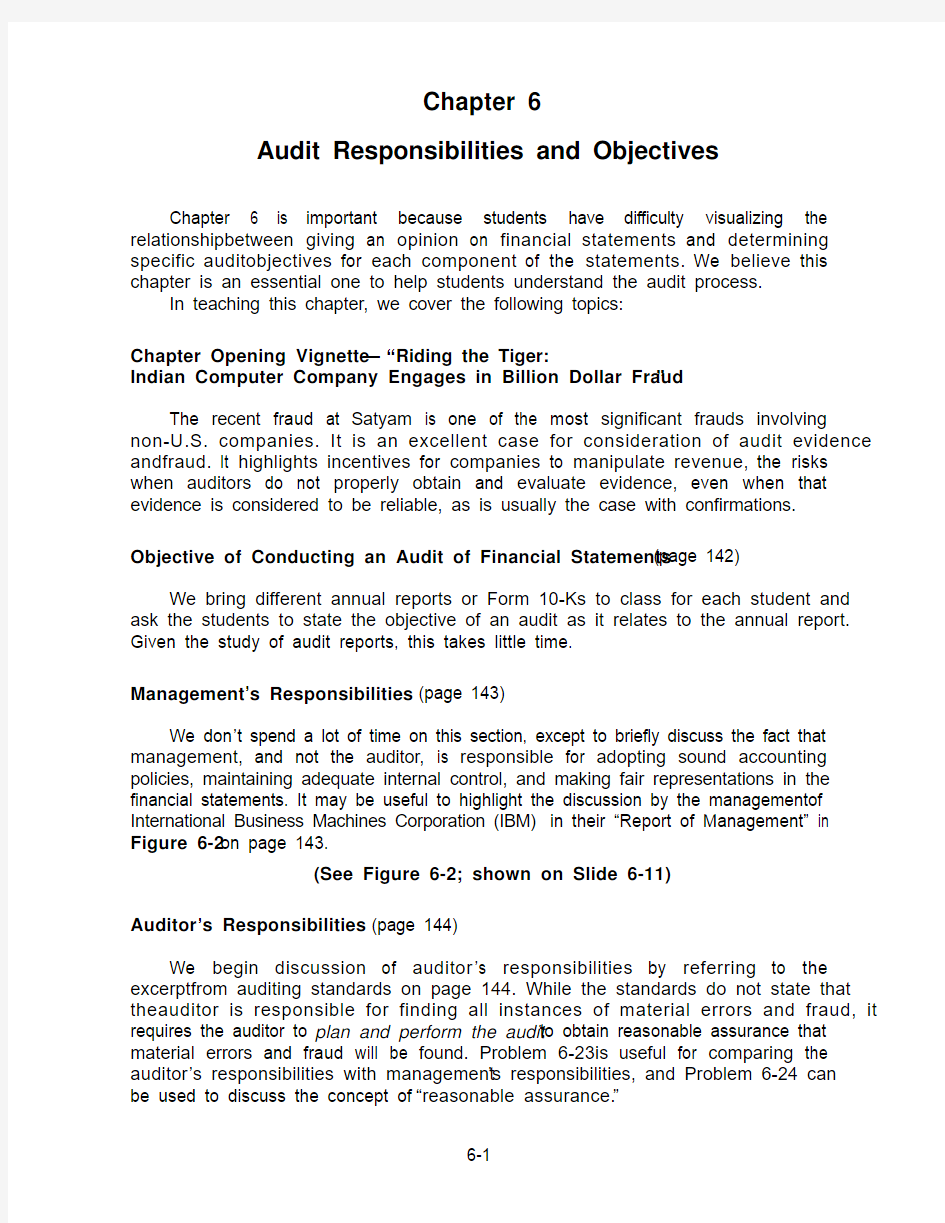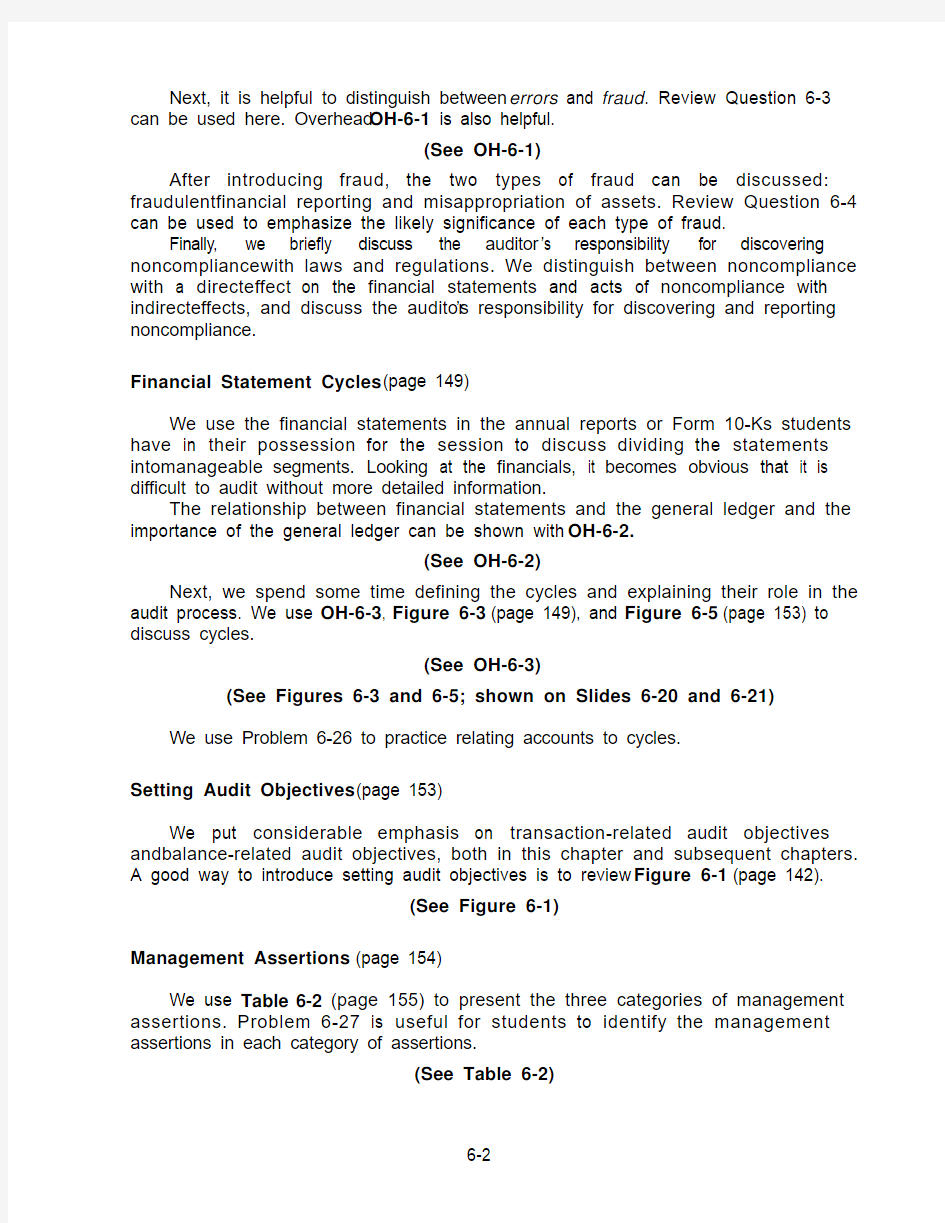arens15_irm_06


Chapter 6
Audit Responsibilities and Objectives Chapter 6 is important because students have difficulty visualizing the relationshipbetween giving an opinion on financial statements and determining specific auditobjectives for each component of the statements. We believe this chapter is an essential one to help students understand the audit process.
In teaching this chapter, we cover the following topics:
Chapter Opening Vignette―“Riding the Tiger:
Indian Computer Company Engages in Billion Dollar Fraud”
The recent fraud at Satyam is one of the most significant frauds involving non-U.S. companies. It is an excellent case for consideration of audit evidence andfraud. It highlights incentives for companies to manipulate revenue, the risks when auditors do not properly obtain and evaluate evidence, even when that evidence is considered to be reliable, as is usually the case with confirmations. Objective of Conducting an Audit of Financial Statements (page 142)
We bring different annual reports or Form 10-Ks to class for each student and ask the students to state the objective of an audit as it relates to the annual report. Given the study of audit reports, this takes little time.
Management’s Responsibilities (page 143)
We don’t spend a lot of time on this section, except to briefly discuss the fact that management, and not the auditor, is responsible for adopting sound accounting policies, maintaining adequate internal control, and making fair representations in the financial statements. It may be useful to highlight the discussion by the managementof International Business Machines Corporation (IBM) in their “Report of Management” in Figure 6-2on page 143.
(See Figure 6-2; shown on Slide 6-11)
Auditor’s Responsibilities (page 144)
We begin discussion of auditor’s responsibilities by referring to the excerptfrom auditing standards on page 144. While the standards do not state that theauditor is responsible for finding all instances of material errors and fraud, it requires the auditor to plan and perform the audit to obtain reasonable assurance that material errors and fraud will be found. Problem 6-23is useful for comparing the auditor’s responsibilities with management’s responsibilities, and Problem 6-24 can be used to discuss the concept of “reasonable assurance.”
Next, it is helpful to distinguish between errors and fraud. Review Question 6-3 can be used here. Overhead OH-6-1 is also helpful.
(See OH-6-1)
After introducing fraud, the two types of fraud can be discussed: fraudulentfinancial reporting and misappropriation of assets. Review Question 6-4 can be used to emphasize the likely significance of each type of fraud.
Finally, we briefly discuss the auditor’s responsibility for discovering noncompliancewith laws and regulations. We distinguish between noncompliance with a directeffect on the financial statements and acts of noncompliance with indirecteffects, and discuss the auditor’s responsibility for discovering and reporting noncompliance.
Financial Statement Cycles (page 149)
We use the financial statements in the annual reports or Form 10-Ks students have in their possession for the session to discuss dividing the statements intomanageable segments. Looking at the financials, it becomes obvious that it is difficult to audit without more detailed information.
The relationship between financial statements and the general ledger and the importance of the general ledger can be shown with OH-6-2.
(See OH-6-2)
Next, we spend some time defining the cycles and explaining their role in the audit process. We use OH-6-3, Figure 6-3 (page 149), and Figure 6-5 (page 153) to discuss cycles.
(See OH-6-3)
(See Figures 6-3 and 6-5; shown on Slides 6-20 and 6-21) We use Problem 6-26 to practice relating accounts to cycles.
Setting Audit Objectives (page 153)
We put considerable emphasis on transaction-related audit objectives andbalance-related audit objectives, both in this chapter and subsequent chapters.
A good way to introduce setting audit objectives is to review Figure 6-1 (page 142).
(See Figure 6-1)
Management Assertions (page 154)
We use Table 6-2 (page 155) to present the three categories of management assertions. Problem 6-27 is useful for students to identify the management assertions in each category of assertions.
(See Table 6-2)
Transaction-Related Audit Objectives (page 157)
It is useful to cover each general transaction-related audit objective in detail. We suggest using OH-6-4 during this discussion. Table 6-3 (page 158) can be used to illustrate specific transaction-related audit objectives for each general transaction-related audit objective.
(See OH-6-4)
(See Table 6-3; shown on Slide 6-31)
Problem 6-29 is useful to relate general transaction-related audit objectives to management assertions and specific transaction-related audit objectives.
Balance-Related Audit Objectives (page 159)
Weuse OH-6-5 as a frame of reference to discuss the general balance-related audit objectives. Table 6-4(page 161) can be used to illustrate specific balance-related audit objectives for each general balance-related audit objective.
(See OH-6-5)
(See Table 6-4; shown on Slide 6-36)
Problem 6-28 or Problem 6-30 can be used to address specific balance-related objectives.
Presentation and Disclosure-Related Audit Objectives (page 162) Next, we discuss the presentation and disclosure-related audit objectives.Table 6-5 (page 162) can be used to illustrate specific presentation and disclosure-related audit objectives for each general presentation and disclosure-related audit objective.
(See Table 6-5)
After discussing the three categories of audit objectives, Problem 6-31 is useful to relate specific audit objectives to general balance-related, transaction-related, and presentation and disclosure-related audit objectives.
How Audit Objectives are Met (page 162)
It is useful to finish the chapter by briefly discussing how audit objectives are met. Display Figure 6-7 (page 163) and discuss it briefly. We refer back to Figure 6-7 in later chapters.
(See Figure 6-7; shown on Slide 6-41)
Problem 6-32 can be used to related specific audit activities to phases of the audit process.
CHAPTER 6
CROSS-REFERENCE OF LEARNING OBJECTIVES AND PROBLEM MATERIAL
6-4
THREE EQUALLY MATERIAL
ERRORS OR FRAUDS
1. Unintentional use of inventory method not in
accordance with GAAP.
2. Employee does not record cash sales in cash
register and keeps the cash.
3. Management withholds information from auditor
about a lawsuit for a patent infringement and
does not include it as a footnote.
●Which are errors and which are frauds?
●Should auditors have equal responsibilities for
discovering each one?
RELATIONSHIP OF FINANCIAL STATEMENTS TO ACCOUNT
BALANCES
──
──
CYCLES USED IN TEXT
●Sales and collection
●Acquisition and payment
●Payroll and personnel
●Inventory and warehousing
●Capital acquisition and repayment
GENERAL TRANSACTION-RELATED AUDIT OBJECTIVES
Occurrence
Completeness
Accuracy
Posting and Summarization
Classification
Timing
GENERAL BALANCE-RELATED AUDIT OBJECTIVES
Existence
Completeness
Accuracy
Classification
Cutoff
Detail Tie-in
Realizable Value
Rights and Obligations
